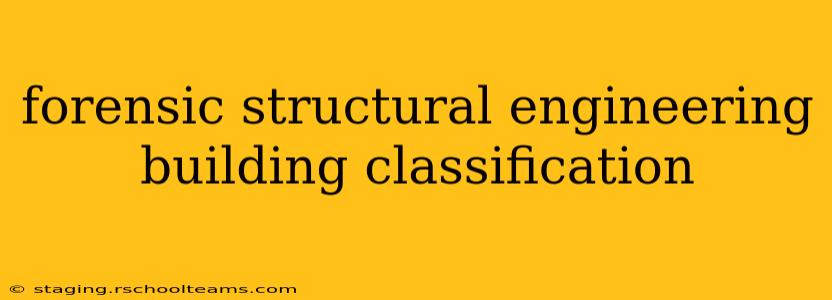Forensic structural engineering delves into the causes of building failures, collapses, and other structural issues. A crucial first step in any forensic investigation is classifying the building. This classification informs the investigation's scope, methodology, and ultimately, its conclusions. This article explores the various ways buildings are classified in forensic structural engineering investigations, highlighting the importance of accurate classification for successful outcomes.
What is Forensic Structural Engineering?
Forensic structural engineering is a specialized field that applies engineering principles to investigate structural failures, accidents, and damage to buildings and other structures. It's akin to detective work for engineers, requiring meticulous analysis, evidence gathering, and a deep understanding of structural mechanics and materials. The goal is to determine the root cause of the issue, assess responsibility, and inform future design and construction practices to prevent similar incidents.
Key Building Classifications in Forensic Investigations
Several factors contribute to how a building is classified within a forensic investigation. These classifications are not mutually exclusive and often overlap:
1. Building Type:
This is a fundamental classification based on the primary function of the building. Examples include:
- Residential: Houses, apartments, condos. Investigations might focus on foundation issues, material defects, or code compliance.
- Commercial: Offices, retail spaces, shopping malls. These investigations may involve more complex structural systems and potentially higher occupancy loads.
- Industrial: Factories, warehouses, power plants. These structures often involve heavy machinery and unique loading conditions, demanding specialized expertise.
- Institutional: Hospitals, schools, government buildings. Life safety is paramount in these investigations, requiring rigorous analysis and adherence to stringent regulations.
2. Construction Material:
The materials used in a building's construction significantly influence its structural behavior and susceptibility to failure. Common classifications include:
- Concrete: Reinforced concrete, prestressed concrete, etc. Investigations may involve analyzing concrete strength, reinforcement detailing, and cracking patterns.
- Steel: Steel frames, steel-concrete composite structures. Corrosion, fatigue, and connection failures are common areas of investigation.
- Masonry: Brick, block, stone. Considerations include mortar quality, wall stability, and seismic performance.
- Timber: Wooden frames, engineered wood products. Issues like decay, insect infestation, and connection failures are often investigated.
3. Structural System:
The overall structural system determines how loads are transferred and resisted. Key classifications include:
- Frame Structures: Steel or concrete frames supporting the building's loads.
- Bearing Wall Structures: Walls carry the loads, with limited or no internal framing.
- Shear Wall Structures: Walls designed to resist lateral loads, typically in earthquake-prone areas.
- Hybrid Structures: Combining different structural systems.
4. Age and Condition:
The age of a building and its current condition are critical factors. Older buildings may have deteriorated materials or outdated design practices, while newer structures might have construction defects or unforeseen material issues.
How Building Classification Impacts Forensic Investigations
Accurate building classification is paramount for a successful forensic structural engineering investigation. It dictates several aspects:
- Scope of Investigation: The type of building dictates the areas requiring closer scrutiny.
- Methodology: The investigation's approach will vary based on the building’s age, materials, and structural system.
- Expertise Required: Different building types necessitate specialized knowledge and experience.
- Applicable Codes and Standards: Classification determines the relevant building codes and standards to be referenced during the investigation.
People Also Ask (PAA) Questions & Answers
Here are some common questions regarding forensic structural engineering and building classification:
What are the common causes of building failures that forensic engineers investigate?
Common causes include design flaws, material defects, construction errors, inadequate maintenance, overloading, environmental factors (e.g., earthquakes, hurricanes), and unforeseen events (e.g., explosions, collisions).
How is a forensic structural engineer different from a regular structural engineer?
While both have expertise in structural mechanics, forensic engineers specialize in investigating past failures, utilizing investigative techniques and legal considerations that are less crucial for regular structural engineering.
What is the role of non-destructive testing (NDT) in forensic investigations?
NDT methods like ultrasonic testing, ground-penetrating radar, and visual inspection play a crucial role in assessing the condition of the building without causing further damage, allowing for the discovery of hidden defects.
What are the legal implications of forensic structural engineering reports?
These reports often serve as critical evidence in legal proceedings related to building failures, providing expert testimony to determine liability and support insurance claims. Accuracy and meticulous documentation are crucial.
Can I use a forensic structural engineering report to claim insurance for my damaged building?
In many cases, a comprehensive report detailing the cause of damage is needed to support insurance claims. The report must clearly establish the extent and cause of the damage and comply with insurance company requirements.
This comprehensive guide offers insight into the crucial role of building classification in forensic structural engineering investigations. Understanding these classifications allows for more efficient, effective, and accurate investigations, ultimately improving building safety and preventing future failures.
